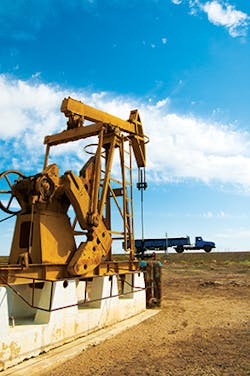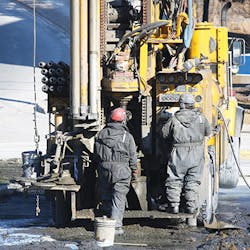Randy Rogers
Joe Derajtys
Exel
Westerville, Ohio
The energy industry continues to undergo a seismic shift. While the ongoing revolution within the industry is still driven by development of unconventional oil and gas, the recent boom in production from shale has encountered a slight hiccup-primarily caused by the considerable dip in commodity pricing.
Many unconventional oil and natural gas sites will continue to be worthwhile to develop.
However, given the low price environment, producers and suppliers are being forced to take an especially hard look at all aspects of their operations to identify areas that might provide potential efficiency gains and opportunities to cut cost.
As producers evaluate their supply chains, one area that is commonly overlooked is maintenance productivity, often referred to as "time on tool."
This is the amount of time mechanics spend on actual maintenance activity. In many cases, this area offers substantial opportunity for efficiency gains and lower costs.
This article explains how producers can take advantage of that opportunity through actions that can result in relatively quick and considerable return on investment.
Remoteness adds complexities
To understand the cost-saving opportunity that exists with the time on tool aspect of the inbound supply chain, it is important to first understand the supply chain challenges.
The difficulties associated with horizontal drilling and fracturing are well documented. Considerable amounts of water, sand, and chemicals are required to efficiently access the oil and gas found in unconventional reservoirs. The coordination required at the drill site is substantial and not unlike that seen in processing a harvest or in a military engagement.
The above scenario plays out at a high rate of frequency because of the nature of unconventional basins. First, the lack of a single, contiguous reservoir from which to draw increases the number of wells required to exploit tight formations. The resulting operation reflects a factory concept for exploration and production, which emphasizes high-asset utilization and low downtime.
Second, output from these unconventional sites declines much more rapidly than the output from conventional wells. The average decline of tight oil wells in North Dakota's Bakken formation, for instance, is 44% per year, with some wells losing 70% or more of their production in the first year.1 In contrast, conventional oil or gas wells can maintain a high level of production for many years-even decades- with an average decline of about 5% per year.2
Because of this high-decline rate, more and more wells must be drilled just to maintain production and significant further investment made in workovers of existing wells. For example, the Eagle Ford shale play in South Texas has over 250 operating rigs. Operators needed to drill over 6,000 wells in 2013, in part to maintain current production rates.3
Giving Focus to Time on Tool
Because the unconventional energy market is so new and the supply chain support system is evolving rapidly, logistics costs can be a much higher proportion of overall production costs. Much of the present exploration and development of US shale gas deposits is not being made by the traditional oil majors, but rather by new players in the market. These new participants frequently have less experience executing the development of efficient supply chains.
These companies do understand that logistics complexities in the unconventional sector can quickly drive up costs and eat into profit margins, if not well managed. They are placing growing emphasis on finding and eliminating waste in their supply chains. Many of these leading companies understand that the aforementioned aspect of just-in-time material coordination and delivery to well pads, for example, must be operated with the same sophistication as warehouses and factories that support industries such as automotive and technology.
When it comes to the supply chain for unconventional energy production, the primary focus has typically been on those areas seen as having the most direct impact on achieving initial site production. This often includes aspects of well preparation, which is associated with rigs and the necessary supporting infrastructure; the in-bound supply chain, which deals with bringing in and staging the materials associated with drilling; and the out-bound supply chain, which involves transporting the oil and gas produced in the fields. Many producers and suppliers regularly examine these areas of the supply chain and routinely make adjustments and improvements.
Given the criticality of these areas and the sensitivity around making changes that could potentially negatively impact time to achieve full production, many companies are confident they have made substantial efficiency and cost-cutting gains. And given the cost deflation seen in the past 12 months, they may actually be correct.
For most unconventional energy providers, the back half of the equation-ensuring existing wells continue to produce effectively-remains an opportunity. By association, mechanic time on tool is one of the supply chain aspects that often falls outside of the intense focus. When you consider the costs associated with drilling, fracturing, and refracturing unconventional sites, maintenance is a relatively modest area of spend, and one that is viewed as vital to uptime so it generally receives appropriate funding. However, the aspect of improving maintenance productivity remains an opportunity.
The best way to address the opportunity is to focus on two primary goals: planning and execution.
Planning key to maintenance
The single biggest input to improving time on tool is a good maintenance plan. In well-planned and geographic proximate settings such as manufacturing facilities, a time on tool percentage of 50-60% is a reasonable goal. For unconventional field operations covering large basins, such as the Bakken formation of North Dakota and Marcellus formation of Pennsylvania, a time on tool rate of less than 30% is more likely.
Improving the maintenance-planning process involves both addressing data and process related aspects. On the data side, material masters should be examined to ensure completeness and accuracy. The most recent maintenance jobs are a good place to start the examination of the bill of materials (BOM). If most of the BOMs do not align with what was used on the job, it is likely the mechanics ended up spending more time figuring out what they needed and driving to pick it up, than actually doing the work.
From a process perspective the big question is how much of the maintenance work is planned vs break-fix. If the majority is break-fix, that has obvious ramifications for production as well as time on tool. Considering this, moving toward a program in which wells are visited regularly and all components are serviced per manufacturers' guidelines and the company's own experience is key.
Measuring execution
The level of understanding for how maintenance productivity can be improved starts with assessing current performance and mapping existing process. Unfortunately, most companies focused upon onshore oil and gas sites do not have a good perspective on either one. The best way to assess these processes is through established benchmarks for the maintenance jobs themselves (how long should the job take to perform) and either direct or third-party assessment vis-à-vis the benchmarks.
The findings of these activities are likely to show that current time on tool when compared to the benchmark is lower than 30%, with considerable time spent going to get and/or waiting on materials. The detailed process often includes the below steps:
• Mechanics gather at a muster point or muster points for safety briefing and assignments.
• Mechanics drive to assigned well sites to examine work to be done.
• Mechanics drive to material supply points (these are often vendor locations) to get materials. They often have lunch on this run as well.
• Mechanics arrive back at the well site in early afternoon to perform the job.
• If additional materials were required, another driving or waiting cycle might be required.
The potential improvement opportunities range from addressing the entire planning and execution process to components that can offer immediate savings. For instance, some companies work with an outside partner to supply drivers, vehicles, and the logistics-scheduling tools to support maintenance teams in the field. On a very basic level, this means that maintenance and service technicians are now spending more time focused on the task at hand.
For those companies that have also addressed the planning component, scheduled jobs can have materials delivered in advance of maintenance personnel arriving on the site; then a call on demand process is used if additional materials are required. The third-party service can also process returns for those materials that were not needed (another area of cost that can be driven out of the as-is supply chain). This process better enables multiple planned jobs in a day.
This revised process ensures the maintenance personnel are focused on core responsibilities and spending more time doing the jobs they were hired to do, which translates into a higher time-on-tool percentage. Another benefit to bringing this type of predictability to the process is that it is scalable. As the number of drilling sites (and need for mechanics) increases, this type of process helps ensure that the maintenance and service supply chain is more efficiently able to support increased production.
Though time on tool has often been an overlooked aspect of the supply chain for unconventional drilling sites, it can offer some of the best opportunities for efficiency gains and lowering costs. Gaining greater visibility into the process allows companies to make slight adjustments to the process, thereby increasing maintenance productivity and lowering costs.
References
1. Tom Zeller Jr., "Is the US Shale Boom Going Bust?" BloombergView, 2014.
2. European Parliament Research Service, "Unconventional Gas and Oil in North America," 2014, p. 8.
3. http://eaglefordshale.com/, accessed Sept. 13, 2014.
The authors
Randy Rogers serves as Exel's president of the chemicals and business unit for the Americas region. Having joined Exel in 2002, he has held numerous regional leadership roles in operations including vice-president of South America, senior vice-president of Greater China, and chief executive officer of Southern Europe.
Before Exel, he worked for CSX Transportation and established its presence in Mexico.
Rogers earned a BS in Economics from Pennsylvania State University and an MBA from the Monterey Institute of International Studies, a graduate school of Middlebury College. He is fluent in both Spanish and Portuguese.
Joe Derajtys currently serves at the Exel's senior director of strategic accounts of the chemicals & energy business unit for the Americas region. Having joined Exel in 2003, he has held several leadership roles in solutions and product development and has supported all business units with special concentration on chemicals and energy.
Before Exel, Derajtys worked for several companies including BNSF, Manugistics (now JDA) and DSI Transports (now Trimac) where he held product management and central planning roles.
Derajtys has a BS in Engineering from Virginia Tech and an MBA from the University of South Carolina.


